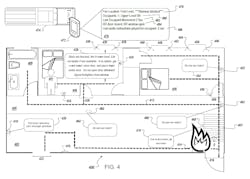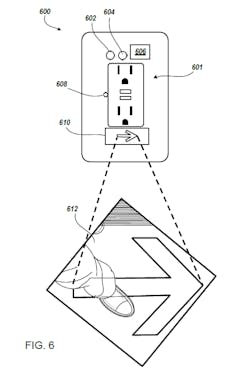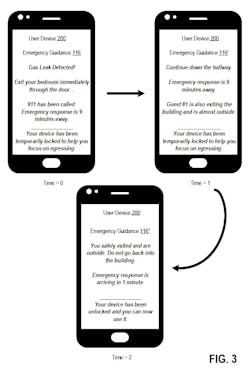The emergence and accessibility of artificial intelligence technology is changing the security industry at a breathtaking pace, which means there is no shortage of new innovations coming out.
But a group of investors at Delaware-based Tabor Mountain LLC believe they have patented technology leveraging the power of AI that could shake up the alarm industry and change the way police and firefighters respond, or train for, a variety of emergencies. And it may also save countless lives, they say.
The new technology, called “Clarus,” leverages artificial intelligence, machine learning, predictive analytics and augmented reality to proactively, and in real-time, detect a variety of emergencies – such as fire, personal safety, active shooters, lockdowns, and other potential threats – and generate emergency egress plans.
The technology would also identify ways to help users reach safety through using configurable and distributed output devices – such as wall switch plates, smoke detectors, carbon monoxide detectors – distributed throughout the building.
The devices collect a variety of signals, such as changes in decibel or other audio levels, temperature, smells or odors, movement, motion and/or images or videos – all of which can be assessed to determine emergency response strategies.
Tabor Mountain says the devices would provide emergency response instructions via voice guidance prompts, lighted visual instructions case on walls, floors, doors or windows, augmented-reality visuals cast on surfaces, and instructions presented on users’ mobile devices via text messages and push notifications.
Clarus could also provide improved training methodologies for responding to different types of emergencies in different types of private and public spaces.
The worldwide patents are 6 years in the making, cover 700 pages and are approved for 18 years.
Looking for Partners
Bill Delmonico, president of Maple Grove, Minn.-based EII Fire And Security, says Tabor Mountain is looking to either do a joint venture, sell the patents or find some other type of sales agreement to leverage the technology in the market.
Delmonico says the technology was developed with the help and advice of people in the firefighting and law enforcement profession, and he sees major alarm companies or perhaps even Big Tech like Dell or Google being players. Ideally, Tabor Mountain wants to find a company with distribution in residential and commercial sectors.
The software has yet to be formally written, and Delmonico is hoping to find a partner that can put several engineers on the task for a year or more to get it written.
“These patents were developed to save lives,” Delmonico told SecurityInfoWatch. “Especially in the shooter detection area, if we went and had this developed with the software, any school in America might buy this system. So it’s a once-in-a-lifetime chance for people in the alarm business to have something that nobody else has.”
Integration Possible
Clarus is described as a suite of different devices and sensors and processors, or computing systems, that communicate wirelessly via Wi-Fi or other means in home and building networks. The sensor devices can include individual sensor components, which can sense the surrounding conditions, including light, sound, temperature, motion and more.
Conditions detected by the sensors can be sent over to a processor or control system that processes those signals and determines whether there’s an emergency in a building, home or other environment.
The sensor devices can also include output devices, which can be audio or visual, including speakers and lighting systems that can project arrows or other types of cues or instructions on the floor, doors or other places to guide occupants out to safety.
Chloe Margulis, a New York-based attorney who is representing the group, says the technology can be integrated into existing building systems that would be able to communicate to the Clarus devices to determine an egress strategy, and the type and gravity of emergency.
Margulis says the software can implement artificial intelligence (AI) techniques and models that have been trained to learn a structure and arrangement of a building and different types of habits of building occupants – such as where users typically spend most of their time or what hallways they take.
“By learning this sort of information, the system can, over time, figure out what the best route is for a particular user to exit the building in a situation where an emergency is detected,” Margulis says. “Once the system is trained, it can just iteratively detect, based on conditions, what type of emergency there is.
“For example,” she adds, “we know that a particular user is in a particular room and has a disability. Based on prior routes that they’ve taken in consideration of their disability, Clarus can automatically determine how to tell that user to egress and what instructions to present to them. So, it's able to provide that more real-time user-customized egress strategy.”
Instructions can be communicated in a variety of ways. As sensor devices detect where occupants are in a building, the system can output instructions in a specific room. Instructions and notifications could also be displayed on mobile devices as well.
Modeling Scenarios
Some “augmented reality” tools can be used to communicate egress routes by casting them onto a wall, door or the floor. If a user is identified as having a handicap, such as being blind, their instructions might be sent as audio cues provided by the sensor devices in the room or outputted by their personal device. For a deaf person the cues would be visual.
Margulis says the system also determines the severity of the emergency to determine if a person should leave their position or stay in place to ensure their safety in the moment.
Margulis says the technology is built so it can communicate the nature and gravity of an emergency automatically with fire and police departments, informing them of where the emergency is located, where the occupants are and whether they’re moving into different areas of the building or staying in place.
The notifications can also indicate where first responders can access the building and how they can help users out via building layouts input into the system.
“Clarus will receive building information so it’s able to model the building and essentially determine many different and possible scenarios in which emergencies may occur in that building, and how users from different rooms in that building layout would potentially be able to egress in all those simulated scenarios,” Margulis says. “That’s how Clarus determines and creates a repository of egress strategies, any of which can then be selected or adapted in real-time when an emergency is detected.”
Active Shooter Response
The AR technology in Clarus could offer crucial help to law enforcement in the event of an active shooter in a building, Margulis says. One example would be generating an image of police officers at the end of the hall, meant to influence the shooter’s behavior and potentially protect occupants in a particular room.
The technology and improved availability of information could help alert officers to where an active shooter is in a building or help police clear rooms faster through awareness of occupants in the building and their location.
Many gunshot-detection systems on the market now, he says, have sensors that detect an event and set off an alarm, but do nothing more.
“The key thing is we can tell you where the gunman is before they get there,” Delmonico says. “Whatever happens right now in augmented reality, it’s going to be different in three months, six months, nine months. We’re saying that the potential with whoever does these patents has that available. There are holograms out there right now, so it’s not farfetched.”
Getting more RMR
Delmonico says this technology, if done right, could potentially be a game changer for the alarm industry, which he says hasn’t released much new technology other than doorbell cameras and AI cameras.
Delmonico also believes the technology could ease concerns about customer attrition in the alarm industry, which he says runs anywhere from 15-20%, with the ability to offer a new safety technology that isn’t completely tied to selling burglar alarms.
“The only thing that's going to help the alarm business to get more RMR is talking about something new,” he says.
Delmonico had discussions with some security industry vendors at ISC West earlier this year but he didn’t receive any commitments, which he believes is a sign executives are having trouble visualizing the technology’s abilities.
He believes property managers for condominiums and apartments would also have an interest in the technology because it will integrate with the fire system they already have. “Insurance companies believe a burglar takes a little, and fire takes all. They know that,” Delmonico says.
John Dobberstein is managing editor of SecurityInfoWatch.com and oversees all content creation for the website. Dobberstein continues a 34-year decorated journalism career that has included stops at a variety of newspapers and B2B magazines.
About the Author
John Dobberstein
Managing Editor/SecurityInfoWatch.com
John Dobberstein is managing editor of SecurityInfoWatch.com and oversees all content creation for the website. Dobberstein continues a 34-year decorated journalism career that has included stops at a variety of newspapers and B2B magazines. He most recently served as senior editor for the Endeavor Business Media magazine Utility Products.




